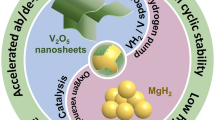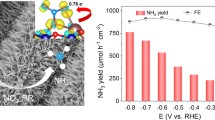Abstract
High-performance thermochemical water splitting catalyst is the key in solar-driven H2 production for the development of sustainable and clean energy technology. Perovskite oxides have been considered promising redox catalysts for two-step thermochemical H2O splitting cycles due to their remarkable oxygen exchange capacity at low thermal heating temperatures. This study is the first to investigate perovskite series of La1−xCaxCoO3 for two-step thermochemical H2O splitting cycles. The Ca doping contents in La1−xCaxCoO3 perovskites showed a significant effect on the O2 and H2 production performances. Increasing the Ca doping content has greatly increased O2 evolution during the thermal reduction process. However, high Ca dopant content significantly weakened the reaction thermodynamics of the subsequent H2O splitting and led to lower re-oxidation yields. After tuning the Ca doping level from 0.2 to 0.8, La0.6Ca0.4CoO3 was identified as the best trade-off among the tested La1−xCaxCoO3 perovskites. The thermal reduction and water splitting temperatures were also systematically investigated to optimize the thermochemical operational conditions. La0.6Ca0.4CoO3 showed maximum H2 production of 587 µmol g−1 when the two-step thermochemical H2O splitting carried out between 1300 and 900 °C, eighteen times higher than that of CeO2 under the same experimental condition. More importantly, La0.6Ca0.4CoO3 also exhibited fairly good catalytic stability during the thermochemical cycling test and has strong potential for long-term applications.








Similar content being viewed by others
References
Hosseini SE, Wahid MA (2016) Hydrogen production from renewable and sustainable energy resources: promising green energy carrier for clean development. Renew Sustain Energy Rev 57:850–866
Wen M, Cui Y, Kuwahara Y, Mori K, Yamashita H (2016) Non-noble-metal nanoparticle supported on metal–organic framework as an efficient and durable catalyst for promoting H2 production from ammonia borane under visible light irradiation. ACS Appl Mater Interfaces 8:21278–21284
Zhu L, Fan J (2015) Thermodynamic analysis of H2 production from CaO sorption-enhanced methane steam reforming thermally coupled with chemical looping combustion as a novel technology. Int J Renew Energy Res 39:356–369
Gil MV, Esteban-Díez G, Pevida C, Chen D, Rubiera F (2014) H2 production by steam reforming with in situ CO2 capture of biomass-derived bio-oil. Energy Procedia 63:6815–6823
Al-Mamun M, Wang Y, Liu P et al (2016) One-step solid phase synthesis of a highly efficient and robust cobalt pentlandite electrocatalyst for the oxygen evolution reaction. J Mater Chem A 4:18314–18321
Al-Mamun M, Su X, Zhang H et al (2016) Strongly coupled CoCr2O4/carbon nanosheets as high performance electrocatalysts for oxygen evolution reaction. Small 12:2866–2871
Al-Mamun M, Yin H, Liu P et al (2017) Carbon-encapsulated heazlewoodite nanoparticles as highly efficient and durable electrocatalysts for oxygen evolution reactions. Nano Res 10:3522–3533
Al-Mamun M, Zhu Z, Yin H et al (2016) The surface sulfur doping induced enhanced performance of cobalt catalysts in oxygen evolution reactions. Chem Commun 52:9450–9453
Ulloa OA, Huynh MT, Richers CP, Bertke JA, Nilges MJ, Hammes-Schiffer S, Rauchfuss TB (2016) Mechanism of H2 production by models for the [NiFe]-hydrogenases: role of reduced hydrides. J Am Chem Soc 138:9234–9245
Zhang J, Qi L, Ran J, Yu J, Qiao SZ (2014) Ternary NiS/ZnxCd1−xS/reduced graphene oxide nanocomposites for enhanced solar photocatalytic H2-production activity. Adv Energy Mater 4:1301925–1301930
Steinfeld A (2005) Solar thermochemical production of hydrogen: a review. Sol Energy 78:603–615
Loutzenhiser PG, Meier A, Steinfeld A (2010) Review of the two-step H2O/CO2-splitting solar thermochemical cycle based on Zn/ZnO redox reactions. Materials 3:4922–4938
Weibel D, Jovanovic ZR, Galvez E, Steinfeld A (2014) Mechanism of Zn particle oxidation by H2O and CO2 in the presence of ZnO. Chem Mater 26:6486–6495
Stamatiou A, Loutzenhiser PG, Steinfeld A (2010) Solar syngas production via H2O/CO2 splitting thermochemical cycles with Zn/ZnO and FeO/Fe3O4 redox reactions. Chem Mater 22:851–859
Leveque G, Abanades S (2015) Investigation of thermal and carbothermal reduction of volatile oxides (ZnO, SnO2, GeO2, and MgO) via solar-driven vacuum thermogravimetry for thermochemical production of solar fuels. Thermochim Acta 605:86–94
Leveque G, Abanades S (2013) Kinetic analysis of high-temperature solid–gas reactions by an inverse method applied to ZnO and SnO2 solar thermal dissociation. Chem Eng J 217:139–149
Gokon N, Mataga T, Kondo N, Kodama T (2011) Thermochemical two-step water splitting by internally circulating fluidized bed of NiFe2O4 particles: successive reaction of thermal-reduction and water-decomposition steps. Int J Hydrogen Energy 36:4757–4767
Kodama T, Gokon N, Yamamoto R (2008) Thermochemical two-step water splitting by ZrO2-supported NixFe3−xO4 for solar hydrogen production. Sol Energy 82:73–79
Miller JE, McDaniel AH, Allendorf MD (2014) Considerations in the design of materials for solar-driven fuel production using metal oxide thermochemical cycles. Adv Energy Mater 4:1300469–1300488
Roeb M, Neises M, Monnerie N et al (2012) Materials-related aspects of thermochemical water and carbon dioxide splitting: a review. Materials 5:2015–2054
Takacs M, Scheffe JR, Steinfeld A (2015) Oxygen nonstoichiometry and thermodynamic characterization of Zr doped ceria in the 1573–1773 K temperature range. Phys Chem Chem Phys 17:7813–7822
Scheffe JR, Welte M, Steinfeld A (2014) Thermal reduction of ceria within an aerosol reactor for H2O and CO2 splitting. Ind Eng Chem Res 53:2175–2182
Cooper T, Scheffe JR, Galvez ME, Jacot R, Patzke G, Steinfeld A (2015) Lanthanum manganite perovskites with Ca/Sr A-site and Al B-site doping as effective oxygen exchange materials for solar thermochemical fuel production. Energy Technol 3:1130–1142
Muhich CL, Ehrhart BD, Al-Shankiti I, Ward BJ, Musgrave CB, Weimer AW (2016) A review and perspective of efficient hydrogen generation via solar thermal water splitting. Wiley Interdiscip Rev Energy Environ 5:261–287
Tao S, Irvine JT (2003) A redox-stable efficient anode for solid-oxide fuel cells. Nat Mater 2:320–323
Petric A, Huang P, Tietz F (2000) Evaluation of La–Sr–Co–Fe–O perovskites for solid oxide fuel cells and gas separation membranes. Solid State Ion 135:719–725
Scheffe JR, Weibel D, Steinfeld A (2013) Lanthanum–strontium–manganese perovskites as redox materials for solar thermochemical splitting of H2O and CO2. Energy Fuels 27:4250–4257
Yang CK, Yamazaki Y, Aydin A, Haile SM (2014) Thermodynamic and kinetic assessments of strontium-doped lanthanum manganite perovskites for two-step thermochemical water splitting. J Mater Chem A 2:13612–13623
McDaniel AH, Miller EC, Arifin D et al (2013) Sr- and Mn-doped LaAlO3-delta for solar thermochemical H2 and CO production. Energy Environ Sci 6:2424–2428
McDaniel A, Ambrosini A, Coker E, Miller J, Chueh W, O’Hayre R, Tong J (2014) Nonstoichiometric perovskite oxides for solar thermochemical H2 and CO Production. Energy Procedia 49:2009–2018
Deml AM, Stevanović V, Holder AM, Sanders M, O’Hayre R, Musgrave CB (2014) Tunable oxygen vacancy formation energetics in the complex perovskite oxide SrxLa1−xMnyAl1−yO3. Chem Mater 26:6595–6602
Galvez ME, Jacot R, Scheffe J, Cooper T, Patzke G, Steinfeld A (2015) Physico-chemical changes in Ca, Sr and Al doped LaMnO perovskites upon thermochemical splitting of CO2 via redox cycling. Phys Chem Chem Phys 17:6629–6634
Dey S, Naidu BS, Govindaraj A, Rao CNR (2015) Noteworthy performance of La1−xCaxMnO3 perovskites in generating H2 and CO by the thermochemical splitting of H2O and CO2. Phys Chem Chem Phys 17:122–125
Bork AH, Kubicek M, Struzik M, Rupp JLM (2015) Perovskite La0.6Sr0.4Cr1−xCoxO3 solid solutions for solar-thermochemical fuel production: strategies to lower the operation temperature. J Mater Chem A 3:15546–15557
Dey S, Naidu BS, Rao CNR (2015) Ln0.5A0.5MnO3 (Ln = Lanthanide, A = Ca, Sr) perovskites exhibiting remarkable performance in the thermochemical generation of CO and H2 from CO2 and H2O. Chem Eur J 21:7077–7081
Dey S, Naidu BS, Rao CNR (2016) Beneficial effects of substituting trivalent ions in the B-site of La0.5Sr0.5Mn1−xAxO3 (A = Al, Ga, Sc) on the thermochemical generation of CO and H2 from CO2 and H2O. Dalton Trans 45:2430–2435
Gerasimov E, Kulikovskaya N, Chuvilin A, Isupova L, Tsybulya S (2016) Microstructural changes in La1−xCaxCoO3−δ solid solutions under the influence of catalytic reaction of methane combustion. Top Catal 59:1354–1360
Murai K-I, Nagai K, Takahashi M, Takakusa S, Moriga T (2015) Study of thermoelectric properties of Ca-doped LaCoO3. Mod Phys Lett B 29:1540026–1540030
Dueso C, Thompson C, Metcalfe I (2015) High-stability, high-capacity oxygen carriers: iron oxide-perovskite composite materials for hydrogen production by chemical looping. Appl Energy 157:382–390
Oumezzine M, Amaral J, Mompean F, Hernández MG, Oumezzine M (2016) Structural, magnetic, magneto-transport properties and Bean-Rodbell model simulation of disorder effects in Cr3+ substituted La0.67Ba0.33MnO3 nanocrystalline synthesized by modified Pechini method. RSC Adv 6:32193–32201
Wang L, Al-Mamun M, Zhong YL et al (2017) Ca2+ and Ga3+ doped LaMnO3 perovskite as a highly efficient and stable catalyst for two-step thermochemical water splitting. Sustain Energy Fuels 1:1013–1017
Wang L, Al-Mamun M, Liu P, Wang Y, Yang HG, Zhao H (2017) La1−xCaxMn1−yAlyO3 perovskites as efficient catalysts for two-step thermochemical water splitting in conjunction with exceptional hydrogen yields. Chin J Catal 38:1079–1086
Kumar DA, Selvasekarapandian S, Nithya H, Leiro J, Masuda Y, Kim S-D, Woo S-K (2013) Effect of calcium doping on LaCoO3 prepared by Pechini method. Powder Technol 235:140–147
Melo D, Vieira F, Costa T et al (2013) Lanthanum cobaltite black pigments with perovskite structure. Dyes Pigment 98:459–463
Zhu H, Zhang P, Dai S (2015) Recent advances of lanthanum-based perovskite oxides for catalysis. ACS Catal 5:6370–6385
Athayde DD, Souza DF, Silva AMA, Vasconcelos D, Nunes EHM, Diniz da Costa JC, Vasconcelos WL (2016) Review of perovskite ceramic synthesis and membrane preparation methods. Ceram Int 42:6555–6571
Demont A, Abanades S (2015) Solar thermochemical conversion of CO2 into fuel via two-step redox cycling of non-stoichiometric Mn-containing perovskite oxides. J Mater Chem A 3:3536–3546
Gokon N, Sagawa S, Kodama T (2013) Comparative study of activity of cerium oxide at thermal reduction temperatures of 1300–1550 °C for solar thermochemical two-step water-splitting cycle. Int J Hydrogen Energy 38:14402–14414
Acknowledgements
This work was financially supported by the Australian Research Council (ARC) and the National Natural Science Foundation of China (Grant Nos. 51372248, 51432009).
Author information
Authors and Affiliations
Corresponding author
Ethics declarations
Conflict of interest
The authors declare that they have no conflict of interest.
Electronic supplementary material
Below is the link to the electronic supplementary material.
Rights and permissions
About this article
Cite this article
Wang, L., Al-Mamun, M., Liu, P. et al. Notable hydrogen production on LaxCa1−xCoO3 perovskites via two-step thermochemical water splitting. J Mater Sci 53, 6796–6806 (2018). https://doi.org/10.1007/s10853-018-2004-2
Received:
Accepted:
Published:
Issue Date:
DOI: https://doi.org/10.1007/s10853-018-2004-2




